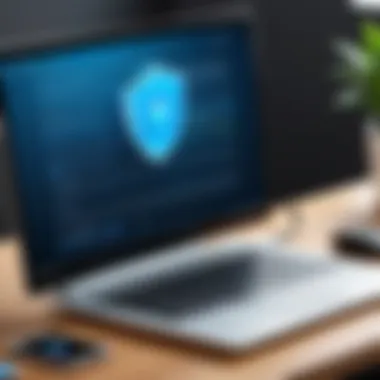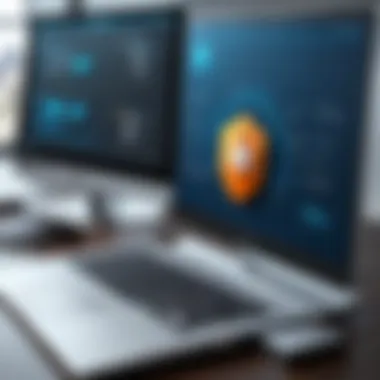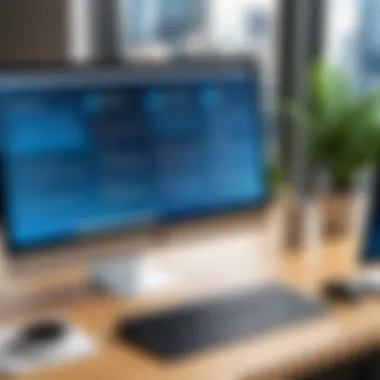Most Secure Remote Desktop Software for Safe Access


Intro
The increasing demand for remote work solutions has transformed the landscape of desktop software. Remote desktop software enables users to access their systems from various locations, making remote access an essential tool for professionals and organizations alike. However, this convenience comes with significant security concerns. In this section, we aim to emphasize the importance of security in remote access technology and explore critical attributes that users should consider in secure remote desktop software.
Security features such as encryption, user authentication, and access controls are vital to protecting sensitive information. Not only do these features prevent unauthorized access, but they also ensure privacy during remote sessions. It is crucial for users to understand these fundamental aspects to comply with regulatory requirements and protect their data integrity.
Thus, calculating the effectiveness of remote desktop tools involves evaluating their security measures rigorously. Readers will grasp a more in-depth perspective on making informed decisions when selecting and implementing remote desktop solutions. The following sections will delve deeper into the software types available on the market and the security protocols they utilize.
Software Overview
In assessing software for remote desktop access, the features and functionalities should come into focus to understand their application. Modern remote desktop software generally encapsulates several key attributes that bolster security and user experience.
Features and functionalities overview
One much acclaim feature is strong encryption protocols. Software providers like Microsoft Remote Desktop and TeamViewer use end-to-end encryption to safeguard data during transmission. Furthermore, many programs combine multi-factor authentication with regular password protection to enhance security. This dual-layer approach effectively thwarts unauthorized access, ensuring that only verified users have entry.
User interface and navigation
When assessing ease of use in remote desktop software, the user interface plays a critical role. Simple navigation tools become essential, particularly for those who may not be technologically adept. Products like AnyDesk demonstrate an efficient design that groups frequently used functions within easy reach. Such considerations greatly enhance the user experience, making it less likely for users to encounter barriers when accessing their systems remotely.
Compatibility and integrations
Compatibility remains a fundamental concern for organizations utilizing various devices. Tools such as Chrome Remote Desktop offer extensive support across multiple operating systems — Windows, macOS, Linux, and Ubuntu. Additionally, integration with applications used in collaboration or management tasks varies by product, affecting day-to-day operation efficiency.
Pros and Cons
Evaluating the advantages and disadvantages allows potential users to discern the right fit for their needs.
Strengths
One key advantage of leading secure remote desktop solutions is the customization they offer. Solutions like LogMeIn provide varied features tailored to business needs, such as session recording and automated termination of idle sessions. These attributes add layers of protection to everyday use.
Weaknesses
On the downside, some remote desktop applications may feature limited connection speeds under specific circumstances. Programs may vary under network pressures or geographical constraints, reducing overall functionality. It is vital for users to navigate support documentation for known limitations.
Comparison with similar software
When comparing similar software products within this sphere, the differences in features substantial. For example, AnyDesk stands out for its speed, while solutions like VNC Connect offer more customization options. Users should weigh the cost and capabilities unique to each software before proceeding.
Pricing and Plans
A relevant aspect of any software evaluation should be its cost. The pricing structure directly influences accessibility for individual users versus larger organizations.
Subscription options
Most remote desktop services offer tiered subscriptions. For instance, Splashtop gives several features under the
Foreword to Remote Desktop Software
Remote desktop software is increasingly relevant in today's digital world. It allows users to access and control a computer from another location. With the rise of flexible work arrangements, personalized security becomes critical. Remote desktop solutions enable workers to connect with their workplace resources securely. This section provides insights on defining remote desktop software and recounting its historical context.
Definition and Purpose
Remote desktop software provides a virtual interface for users to interact with their computers or servers remotely. It serves various functions, facilitating troubleshooting, file access, software usage, and database management. The primary purpose of this software is to extend a user’s digital environment, regardless of geographical constraints. This makes it essential for IT professionals who need prompt access to resolve user issues. Additionally, remote desktop solutions save time and reduce travel costs.
However, it should not be used carelessly. Security significantly impacts the adoption and effectiveness of remote desktop software. By understanding the defined scope and purpose of such tools, users can benefit while adhering to best practices. This makes awareness of the software's capabilities essential in shaping secure remote work practices.
Historical Context


The development of remote desktop software dates back to the mid-1990s. Traditional remote access methods included dialing into a network over modem connections. With advancements in internet connectivity, new protocols emerged, enhancing usability and reliability. Notably, Microsoft's release of Remote Desktop Protocol in 1998 laid the foundation for modern remote access solutions.
In its early years, the focus was primarily on providing access to machines, often lacking significant security measures. Over time, as cybersecurity threats became prevalent, developers began emphasizing security features in their offerings. The combination of innovation and security needs has driven the evolution of remote desktop software, shaping it into a robust tool used extensively across industries.
With the continuous development of technology, it is essential to keep track of the shifts in both capabilities and threats. Understanding its past helps users better appreciate the current landscape of remote desktop solutions and surf safe.
Understanding Security in Remote Desktop Software
Security is a significant concern for professionals regarding remote desktop software. As remote work becomes more common, understanding the security aspects of these tools become essential. Focussing on this area, users can minimize their exposure to threats and protect sensitive information.
The Importance of Security
In today's digital world, security in remote desktop solutions is no longuer optional. It plays a central role in facilitating seamless access for users while keeping data safe. Secure remote desktop software utilizes various technologies to provide protection against unauthorized entry, data breaches, and other forms of cybercriminal activity.
Consider these benefits:
- Data Confidentiality: Employing strict security measures ensures sensitive data remains protected during transmission.
- User Trust: When organizations prioritize security, it fosters trust among end-users and clients.
- Regulatory Compliance: Many businesses need to adhere to regulations like GDPR or HIPAA, where security safeguards must be implemented.
A secure environment promotes smoother operations, essential in today's fast-paced businesses. Any lapse can result in severe consequences, including financial loss and reputational harm.
Common Security Threats
The use of remote desktop software introduces various security challenges that users should be aware of. If not addressed, these threats can lead to severe risks. Identifying common menace allows for corrective measures to be taken swiftly. Some of these threats include:
- Brute Force Attacks: These entail attackers attempting numerous password combinations until they find one that works. Weak password policies can be disastrous, allowing easy access.
- Man-in-the-Middle (MitM) Attacks: Cybercriminals can intercept communications between users and remote servers, obtaining sensitive information. Encrypting communication is crucial in counteracting this threat.
- Rogue Software: Sometimes, fake remote desktop programs target unsuspecting users. These programs can compromise sensitive data or device performance. Always sourcing software through trusted channels can mitigate risks here.
A security-first mindset empowers users to create more secure remote environments. Companies continuing to enhance their virtual security measures will lessen faster recovery time after a breach and protect invaluable information.
Key Features of Secure Remote Desktop Software
The significance of having secure features in remote desktop software cannot be overstated. In an age where remote work has become common, the security of systems can't be overlooked. These features not only protect data but also contribute to operational integrity. By focusing on the elements outlined below, individuals and organizations can select safe and reliable software that meets their remote connection needs while safeguarding sensitive information effectively.
Encryption Protocols
Encryption is a fundamental aspect of securing remote desktop connections. It works by transforming data into a code, making it unreadable to unauthorized users. For any remote desktop software to be considered safe, strong encryption protocols must be employed. The two widely recognized protocols are AES (Advanced Encryption Standard) and RSA (Rivest-Shamir-Adleman).
When implemented correctly, these encryption methods prevent interception of data during transmission. User credentials and session data are converted to an unreadable format, reducing risks posed by malicious attacks. Users typically should look for software that employs end-to-end encryption to ensure a comprehensive security approach.
User Authentication Mechanisms
Strong user authentication mechanisms are essential to control who accesses remote systems. This involves verifying the identity of users before they gain access to sensitive data and applications. Effective methods include multi-factor authentication (MFA) and biometric identification. MFA combines something the user knows, such as a password, with something they have, such as a smartphone app, enhancing security.
In addition, password strength should not be underestimated. Remote desktop software often allows the enforcement of tailor-made password policies, which further assists in minimizing unauthorized access. Optimizing these mechanisms creates an environment where only verified users operate.
Granular Access Control
Granular access control features provide precise permissions to users. This means that not all individuals have the same levels of access. By arranging access in this way, organizations enhance security while allowing users to perform their necessary functions.
For example, an IT administrator may require full access to all files and settings, while a customer service representative needs access only to specified applications. Configuring these permissions minimizes unnecessary vulnerabilities as well. Tracking user activity through logs can also aid in identifying potential misuse or gaps in security control.
Session Recording Capabilities
Session recording capabilities allow organizations to maintain a record of remote access sessions. This is important from both outreach perspective—in the case of providing technical support—and for security audit trails. Recorded sessions can serve as evidence to investigate incidents when they arise,
By reviewing recorded sessions, IT teams can gauge whether or not security protocols are followed. Harsh situations of unauthorized access or breaches may occur, but comprehensive recording features can be crucial for determining outcomes and strengthening security postures in future. Aggregating insights gained from sessions ultimately fuels further improvements.
Key features such as strong encryption, robust user authentication, detailed access control, and thorough recording mechanisms all contribute significantly to security. Investing in software with these features represents a commitment to data integrity.
Overall, these key features must be integral when selecting secure remote desktop software. Focusing heavily on the aforementioned aspects provides not just peace of mind for users but safeguards the endpoint systems comprehensively.


Top Secure Remote Desktop Software Solutions
In today’s dynamic landscape of remote work, selecting the right remote desktop software is crucial for balancing usability and security. With an array of options, professionals must evaluate software based on specific elements such as encryption strength, user authentication practices, and overall performance. Each solution must cater to varied requirements while maintaining a focus on user safety. A discernible trend toward remote access has underscored the urgency for businesses to prioritize secure software. Thus, understanding available solutions will empower users to make informed decisions tailored to their context and security needs.
Software A
Overview
Software A stands out for its streamlined interface and robust functionality. It caters to a wide selection of businesses, breaking the mold of traditional remote access tools. The key characteristic of Software A is its end-to-end encryption, which ensures data remains unreachable by unauthorized entities. This encryption method fosters trust among users and reinforces optimal security practices early in its design. Its unique feature of having built-in malware detection strengthens its position further, ensuring any potential threats are captured. Although the software's operational complexity can increase depending on system requirements, its benefits outweigh these considerations for many organizations.
Security Features
When considering security, Software A emphasizes advanced protocols that enhance its overall protection framework. Multi-layer security features encompass two-factor authentication, minimizing chances of unauthorized logins. These security measures are why Software A is highly regarded in this sector. Additionally, the option for user behavior analytics allows organizations to identify any anomalies. However, implementing these measures could lead to additional setup time, which often is a slight inconvenience depending on user experience.
User Experience
User experience is another hallmark of Software A, designed around simplicity and ease of access. Its customizable dashboard offers accessibility to vital functions right away, enhancing productivity from login onwards. Users appreciate the responsive customer support— a significant aid in resolving any emerging issues. The software's unique onboarding tool guides users through the setup process efficiently. Some users have mentioned these onboarding processes may require patience, especially for non-tech-savvy individuals.
Software B
Overview
Software B is a favorite among IT professionals for its versatility and scalability options. Its integration capacities with third-party apps are geared to smooth operational workflows. Notably, the interface promotes easy accessibility while providing an impressive scalability feature. It is suitable for small businesses growing into enterprises. This software's scheduling functionalities can enhance multitasking significantly. However, integrating with some existing systems may cause slight complexities in user setups, needing attention from deployment teams.
Security Features
Within the realm of security, Software B employs cutting-edge measures such as AES-256 encryption, making sensitive data impregnable during transmission. Secure VPN connectivity further establishes its significance as a primary player in this field. Companies commonly prefer its proactive security alerts, addressing potential concerns before they escalate. Yet, these alerts may overwhelm some users who are still acclimatizing to the software’s expansive functionalities.
User Experience
A less complex layout gives Software B an edge. Users frequently point out the robust help documentation that accompanies the software. The extensive knowledge base becomes valuable for troubleshooting long after the initial settings. Moreover, the compatibility with mobile devices enhances usability, especially in multi-location setups. There are user reports of occasional performance lags during heavy usage periods, which users recommend monitoring to maintain application efficiency.
Software
Overview
Software C is particularly distinguished for its specialization in remote work settings within critical infrastructure industries. Supporting industries such as finance and healthcare, it provides tailored solutions designed to ensure compliance and data protection. The primary characteristic of this software lies in its real-time monitoring capability, giving administrators effective oversight. Users cite this compliance-centric approach as its primary strength. However, organizations may experience a steep learning curve when structuring the necessary compliance features within workflows.
Security Features
Diving into Security Features, Software C implements role-based access controls that dictate user authority across different platforms. This granularity empowers enterprises to set forth better internal security protocols. It also facilitates encrypted connection tunnels that secure the data transfer point adequately during remote access transactions. That said, organizations inclined to customize access controls may require advanced administrative intents that indicate a need for multifaceted training.
User Experience
The user experience of Software C thrives on its high responsiveness to real-time demands. Users highly praise its stability when multiple connections run concurrently. Its built-in feedback system enables quick adjustments based on real user input. Adoption seems finely tuned to meet compliance necessities without ambiguity. Certain users reported issues in reviews regarding document uploads, which often required retries that can be a nuisance in time-sensitive scenarios.
Best Practices for Using Remote Desktop Software Securely
Securing remote desktop connections is essential for protecting sensitive data and maintaining productivity. Best practices encompass not only technical measures but also user behavior and organizational policies. Following these best practices significantly reduces the risk of unauthorized access, data breaches, and cybersecurity incidents.
Regular Software Updates
Keeping your remote desktop software up-to-date is critical for security. Updates often include patches that fix known vulnerabilities, which hackers might exploit. Software developers push these updates to address new threats that arise regularly.
Ignoring these updates could leave systems susceptible. To facilitate a proactive approach, set up automatic updates whenever possible. This practice ensures the software runs the latest version, safeguarding against potential exploits.
Furthermore, assess the software's history of updates. Regularly updated software often indicates active support and commitment to security from developers. Use this information to select a robust remote desktop solution for your work environment.
Strong Password Policies


Password security is one of the cornerstone practice in maintaining a secure remote desktop environment. Enforcing strong password policies from the start minimizes the potential of unauthorized access. A strong password should ideally combine upper and lower case letters, numbers, and special characters. Additionally, they should be at least twelve characters long to enhance security.
Implementing multi-factor authentication adds an extra layer of defense. This method requires not only a password but second verification, such as a code sent to a mobile device or biometrics.
- Educate Users: Make sure everyone using the remote desktop understands the significance of using strong passwords.
- Periodic Changes: Encourage changing passwords routinely and not reusing old passwords across different services.
Firewall and Network Security
Integrating proper firewall and network security is paramount. Firewalls act as a barrier between your remote desktop software and external threats. Ensure that both software firewalls and hardware firewalls are active. This approach prevents unauthorized access and protects sensitive information.
Additionally, implement Virtual Private Networks (VPNs) for secure connections over the internet. VPNs encrypt the data, making it more challenging for attackers to intercept information flowing through untrusted networks.
Educating users about secure networking practices is vital. Advise them to connect only through secured networks and avoid public Wi-Fi when accessing remote systems. This measure drastically reduces vulnerabilities associated with unsecured networks.
Strong security practices foster a safer working environment, significantly reducing risks associated with remote access.
Ensuring adherence to these best practices cultivates a security-conscious culture while using remote desktop software. Implementing steps like regular updates, strong password policies, and effective firewall strategies protects not only the users but the organization's entire infrastructure. Education also plays a crucial role, as informed users are adaptive and less prone to make errors that could jeopardize security.
Legal and Compliance Considerations
Ensuring the security of remote desktop software is not solely a matter of technical configurations or preferable user practices. It extends into the realms of legal and compliance standards that govern data handling and remote access. Ignoring these considerations can expose organizations to significant risks including severe financial penalties and damage to their reputation. Businesses operating in different regions face varying regulations that mandate stringent requirements for data protection and privacy.
Data Protection Regulations
Data protection regulations play a crucial role in shaping the framework around remote desktop software usage. These rules, such as the General Data Protection Regulation (GDPR) in Europe or the Health Insurance Portability and Accountability Act (HIPAA) in the United States, set the standards for how personal data is collected, processed, and stored.
- Accountability: Organizations must demonstrate accountability for the personal data they handle. This includes understanding and documenting how remote desktop software facilitates access to this data.
- Consent: Obtaining user consent for data processing becomes essential. Remote desktop software allows users to access sensitive information, thus models of consent are key to comply with regulations.
- Data Breach Protocols: Clear strategies must be outlined for breaches. Statistics show that many companies may face legal actions due to inadequate response plans.
Digital privacy and user trust hinge on compliance with these regulations, assisting not just in mitigating fallout from violations but also enhancing organizational credibility among stakeholders.
"Regulatory compliance acts as both a compass and a legal sack for businesses navigating the complexities of data privacy."
Industry-Specific Compliance
Every industry exhibits unique compliance challenges related to remote desktop software. Sectors such as finance, healthcare, and education often come under stringent regulatory critical frameworks.
In the finance industry, regulations like the Sarbanes-Oxley Act and Payment Card Industry Data Security Standard (PCI DSS) place strong focus on integrity and accountability in data handling, pushing out software in compliance with these stipulations. Proper remote access controls and logging actions taken during remote sessions must meet these rigorous standards.
For the healthcare sector, the demands outline patient confidentiality strictly, requiring secure channels for healthcare providers to access sensitive records through remote desktops securely.
In the education sector, the Family Educational Rights and Privacy Act (FERPA) governs the handling of students' educational records, laying out necessary protocols for remote access to ensure safety and compliance.
Each field must customize their remote desktop solutions based on operational characteristics and, more importantly, align them with legal frameworks governing those industries. This enables them to not only obey mandates but also to build a solid foundation for ongoing trust with clients and stakeholders.
Being aware of legal specifications and compliance requirements protects organizations further, ensuring smoother functioning while transparently guiding users through their digital interactions.
The End and Future Trends
In the constantly evolving landscape of technology, the significance of secure remote desktop software cannot be overstated. Professionals in IT-related fields must stay informed about the latest trends to ensure the integrity and security of remote access solutions. A more secure remote access environment leads to numerous benefits, including increased trust, enhanced productivity, and protection of sensitive data from unauthorized access.
Emerging Technologies
New innovations continuously reshape how remote desktop software functions. Several emerging technologies hold promise for improving security in remote access:
- Artificial Intelligence can predict potential security threats by analyzing user behavior, which allows for more proactive defense mechanisms.
- Machine Learning algorithms enhance user authentication systems, making it harder for unauthorized individuals to gain access.
- Blockchain Technology offers secure data transactions and could forever change access reliability stages in software design. Such technologies develop more secure and integrated remote desktop experiences.
By implementing these emerging technologies, organizations can not only improve their security postures but can also adapt more quickly to any potential cybersecurity risks that arise.
Anticipated Changes in Security Protocols
Future trends indicate we can expect substantial changes to security protocols that govern remote desktop software. As cyber threats evolve, responses from developers and organizations must be equally dynamic. Some anticipated changes include:
- Zero Trust Architecture will become mainstream, encouraging verification at every access point. This concept challenges the outdated belief that trusted environments inherently lead to secure connections.
- Advanced Encryption Standards are expected to be refined and utilized widely, ensuring data remains protected during transmission.
- Increased Use of Multi-Factor Authentication (MFA) to strengthen user access checks. Organizations will adopt more rigorous controls to fortify direct connections between devices and servers.
The security landscape in remote desktop software is progressing. As threats become increasingly sophisticated, so too must the forging of far more robust and complex security measures.
Ultimately, focusing on these trends in secure remote desktop software will empower professionals to select viable tools for their needs. Judicious implementation will lead to higher safety in remote accessing practices, solidifying a future where connections are both seamless and secure.







